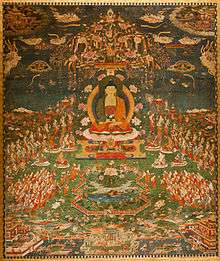Pure Land Buddhism
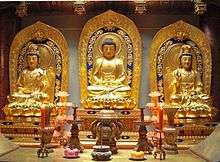
| Part of a series on |
| Mahāyāna Buddhism |
|---|
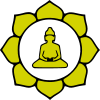 |
|
Teachings |
|
Mahāyāna schools |
|
|
Pure Land Buddhism (simplified Chinese: 净土宗; traditional Chinese: 淨土宗; pinyin: Jìngtǔzōng; Japanese: 浄土仏教[1], Jōdo bukkyō; Korean: 정토종, jeongtojong; Vietnamese: Tịnh Độ Tông), also referred to as Amidism[2][3] in English, is a broad branch of Mahāyāna Buddhism and one of the most widely practiced traditions of Buddhism in East Asia. Pure Land is a tradition of Buddhist teachings that are focused on Amitābha Buddha. The three primary texts of the tradition, known as the "Three Pure Land Sutras", are the Infinite Life Sutra, the Amitabha Sutra and the Amitayurdhyana Sutra.
Pure Land oriented practices and concepts are found within basic Mahāyāna Buddhist cosmology, and form an important component of the Mahāyāna Buddhist traditions of China, Japan, Korea, Vietnam and Tibet. The term "Pure Land Buddhism" is used to describe both the Pure Land soteriology of Mahāyāna Buddhism, which may be better understood as "Pure Land traditions" or "Pure Land teachings," and the separate Pure Land sects that developed in Japan.
Early history
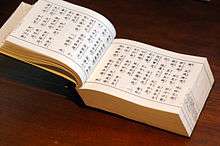
History in India
The Pure Land teachings were first developed in India, and were very popular in Kashmir and Central Asia, where they may have originated.[4] Pure Land sutras were brought from the Gandhāra region to China as early as 147 CE, when the Kushan monk Lokakṣema began translating the first Buddhist sūtras into Chinese.[5] The earliest of these translations show evidence of having been translated from the Gāndhārī language, a prakrit language related to Sanskrit.[6] There are also images of Amitābha Buddha with the bodhisattvas Avalokiteśvara and Mahāsthāmaprāpta which were made in Gandhāra during the Kushan era.[7]
In the Buddhist traditions of India, Pure Land doctrines and practices were disseminated by well-known exponents of the Mahāyāna teachings, including Nāgārjuna and Vasubandhu.[8] Although Amitābha is honored and venerated in Pure Land traditions, this was clearly distinguished from worship of the Hindu gods, as Pure Land practice has its roots in the Buddhist ideal of the bodhisattva.[9]
Pure Land sutras
The three principal Pure Land sūtras are the Amitabha Sutra, the Infinite Life Sutra, and the Amitayurdhyana Sutra. These sutras describe Amitābha and his Pure Land of Bliss, called Sukhavati. Also related to the Pure Land tradition is the Pratyutpanna Samādhi Sūtra, which gives an early description of the practice of reciting the name of Amitābha Buddha as a meditation method, although it does not enumerate any vows of Amitābha or the qualities of Sukhāvatī.[10]
Bodhisattvas hear about the Buddha Amitābha and call him to mind again and again in this land. Because of this calling to mind, they see the Buddha Amitābha. Having seen him they ask him what dharmas it takes to be born in the realm of the Buddha Amitābha. Then the Buddha Amitābha says to these bodhisattvas: "If you wish to come and be born in my realm, you must always call me to mind again and again, you must always keep this thought in mind without letting up, and thus you will succeed in coming to be born in my realm."
In addition to these sutras, many other Mahāyāna texts also feature Amitābha Buddha, and a total of 290 such works have been identified in the Taishō Tripiṭaka.[11]
Andrew Skilton writes that the descriptions of Sukhāvatī given in the Sukhāvatīvyūha sūtras (Infinite Life Sutra and Amitabha Sutra) suggests that these descriptions were originally used for meditation:[12]
This land, called Sukhāvatī or "blissful," is described in great detail, in a way that suggests that the sūtras were to be used as guides to visualization meditation, and also gives an impression of a magical world of intense visual and sonorous delight.
In the Infinite Life Sutra, the Buddha begins by describing to his attendant Ānanda a past life of the buddha Amitābha. He states that in a past life, Amitābha was once king who renounced his kingdom, and became a monastic bodhisattva named Dharmākara ("Dharma Storehouse").[13] Under the guidance of the buddha Lokeśvararāja ("World Sovereign King"), innumerable buddha-lands throughout the ten directions were revealed to him.[13] After meditating for five eons as a bodhisattva, he then made a great series of vows to save all sentient beings, and through his great merit, created the realm of Sukhāvatī ("Ultimate Bliss").[13][14] This land of Sukhāvatī would later come to be known as the Pure Land (Ch. 淨土) in Chinese translation.
Early history in China
The Pure Land teachings first became prominent in China with the founding of Donglin Temple at Mount Lu (Ch. 廬山) by Huiyuan (Ch. 慧遠) in 402 CE. As a young man, Huiyuan practiced Daoism, but felt the theories of immortality to be vague and unreliable, and unrepresentative of the ultimate truth.[15] Instead, he turned to Buddhism and became a monk learning under Dao An (Ch. 道安). Later he founded a monastery at the top of Mount Lu, and invited well-known literati to study and practice Buddhism there, where they formed the White Lotus Society (Ch. 白蓮社).[16] They accepted the Shorter Sukhāvatīvyūha Sūtra and the Longer Sukhāvatīvyūha Sūtra as their standards among the Buddhist sūtras, and they advocated the practice of reciting the name of Amitābha Buddha in order to attain rebirth in the western pure land of Sukhāvatī.[17] The Mount Lu is regarded as the among the most sacred religious sites of the Pure Land Buddhist tradition,[18] and the site of the first Pure Land gathering.[19]
The Pure Land teachings and meditation methods quickly spread throughout China and were systematized by a series of elite monastic thinkers, namely Tanluan, Daochuo, Shandao, and others. The main teaching of the Chinese Pure Land tradition is based on focusing the mind with Mindfulness of the Buddha (Skt. buddhānusmṛti) through recitation of the name of Amitābha Buddha, so as to attain rebirth in his pure land of Sukhāvatī.[20] Early Pure Land as practiced in China by Tanluan is described as follows:[21]
[Tanluan] describes the visualization of Amitābha and Sukhāvatī in minute detail, he regards the invocation of the Buddha's name as a spell working in the inconceivable realm (acintya-dhātu), and he describes how the realized Pure Land devotee manifests human (nirmita) bodies in all times and places. His knowledge of Buddhism is deep. He uses over twenty sūtras and more than a dozen śāstras to argue his case. There are eighty-one references to the Mahāprajñāpāramitā-śāstra alone, and twenty-one references to the Chinese Mādhyamaka Master Sengchao, none of them trivial or out of place.
At a later date, the Pure Land teachings spread to Japan and slowly grew in prominence. Genshin (942-1017) caused Fujiwara no Michinaga (966-1028) to accept the Pure Land teachings. Hōnen (1133–1212) established Pure Land Buddhism as an independent sect in Japan, known as Jōdo Shu. Today Pure Land is an important form of Buddhism in Japan, China, Korea, Taiwan, and Vietnam.
The Pure Land
Contemporary Pure Land traditions see Amitābha expounding the Dharma in his buddha-field (Skt. buddhakṣetra), or "pure land" (Ch. 净土, Jìngtǔ), a region offering respite from karmic transmigration. Amitābha's pure land of Sukhāvatī is described in the Longer Sukhāvatīvyūha Sūtra as a land of beauty that surpasses all other realms. It is said to be inhabited by many gods, men, flowers, fruits, and adorned with wish-granting trees where rare birds come to rest.[22] In Pure Land traditions, entering the Pure Land is popularly perceived as equivalent to the attainment of enlightenment. Upon entry into the Pure Land, the practitioner is then instructed by Amitābha Buddha and numerous bodhisattvas until full and complete enlightenment is reached. This person then has the choice of returning at any time as a bodhisattva to any of the six realms of existence in order to help all sentient beings in saṃsāra, or to stay the whole duration, reach Buddhahood, and subsequently deliver beings to the shore of liberation.
In Mahāyāna Buddhism, there are many buddhas, and each buddha has a pure land. Amitābha's pure land of Sukhāvatī is understood to be in the western direction, whereas Akṣobhya's pure land of Abhirati is to the east. Though there are other traditions devoted to various Pure Lands, each of Pure Lands except Amitābha's is called by the different name without calling it pure land, and Amitabha's is by far the most popular. However, Amitabha's Pure Land Buddhism also preach to the populace about the terror of underworld as one's postmortem process. It may be terrible rather than other Buddhism. Therefore, few Pure Land buddhists have practiced the harder Pratyutpanna samadhi.
Sutras of Pure Land Buddhism preaches that Dharma brings effects equally without distinction of saints or the imperial family. This is one of the reasons that became most popular among the populace. In addition, it references that benevolences expecting the reward do not have good deeds, and suggests that good and evil may be interchanged in the difference of one's situation. Hence, it was thought that menial persons could be released from the underworld like Hell and arrive at Pure Land easily depending on their good deeds in one's lifetime. However, because this teaching includes extremely difficult subject matter, various denominations or sects appeared over the interpretation.
Meditation
Charles Luk identifies three meditation practices as being widely used in Pure Land Buddhism.[23]
Mindfulness of Amitābha Buddha
Repeating the name of Amitābha Buddha is traditionally a form of Mindfulness of the Buddha (Skt. buddhānusmṛti). This term was translated into Chinese as nianfo, by which it is popularly known in English. The practice is described as calling the buddha to mind by repeating his name, to enable the practitioner to bring all his or her attention upon that buddha (See: samādhi).[24] This may be done vocally or mentally, and with or without the use of Buddhist prayer beads. Those who practice this method often commit to a fixed set of repetitions per day.[24] According to tradition, the second patriarch of the Pure Land school, Shandao, is said to have practiced this day and night without interruption, each time emitting light from his mouth. Therefore, he was bestowed with the title "Great Master of Light" (光明大師) by the Tang Dynasty emperor Gao Zong (Ch. 高宗).[25]
In Chinese Buddhism, there is a related practice called the "dual path of Chán and Pure Land cultivation", which is also called the "dual path of emptiness and existence."[26] As taught by Nan Huai-Chin, the name of Amitābha Buddha is recited slowly, and the mind is emptied out after each repetition. When idle thoughts arise, the phrase is repeated again to clear them. With constant practice, the mind is able to remain peacefully in emptiness, culminating in the attainment of samādhi.[26]
Pure Land Rebirth Dhāraṇī
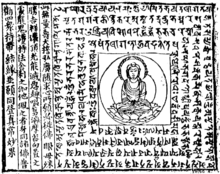
Repeating the Pure Land Rebirth Dhāraṇī is another method in Pure Land Buddhism. Similar to the mindfulness practice of repeating the name of Amitābha Buddha, this dhāraṇī is another method of meditation and recitation in Pure Land Buddhism. The repetition of this dhāraṇī is said to be very popular among traditional Chinese Buddhists.[25] It is traditionally preserved in Sanskrit, and it is said that when a devotee succeeds in realizing singleness of mind by repeating a mantra, its true and profound meaning will be clearly revealed.[25]
- namo amitābhāya tathāgatāya tadyathā
- amṛt[od]bhave amṛta[siddhambhave]
- amṛtavikrānte amṛtavikrāntagāmini
- gagana kīrtī[kare] svāhā
The Chinese use a version of this dhāraṇī that was transliterated from Sanskrit into Chinese characters, called the "Mantra for Birth in the Pure Land" (生淨土咒 Sheng Jingtu Zhou)[27] also known as the Pure Land Rebirth Dhāraṇī (往生淨土神咒 Wangsheng Jingtu Shenzhou). The translation exists in various forms and this is one commonly used.
Visualization methods
Another practice found in Pure Land Buddhism is meditative contemplation and visualization of Amitābha Buddha, his attendant bodhisattvas, and the Pure Land. The basis of this is found in the Amitāyurdhyāna Sūtra ("Amitābha Meditation Sūtra"), in which the Buddha describes to Queen Vaidehi the practices of thirteen progressive visualization methods, corresponding to the attainment of various levels of rebirth in the Pure Land.[28] The first of these steps is contemplation of a setting sun, until the visualization is clear whether the eyes are open or closed.[29] Each progressive step adds complexity to the visualization of Sukhāvatī, with the final contemplation being an expansive visual which includes the Amitābha Buddha and his attendant bodhisattvas.[29] According to Inagaki Hisao, this progressive visualization method was widely followed in the past for the purpose of developing samādhi.[9] Visualization practises for Amitābha are also popular in Japanese Shingon Buddhism as well as other schools of Esoteric Buddhism.
Going to the Pure Land
Practitioners claim there is evidence of dying people going to the pure land, such as:
- Knowing the time of death (預知時至): some prepare by bathing and reciting the name of the Buddha Amitabha.
- The "Three Saints of the West" (西方三聖): Amitābha Buddha and the two bodhisattvas, Avalokiteśvara on his right and Mahāsthāmaprāpta on his left, appear and welcome the dying person. Visions of other buddhas or bodhisattvas are disregarded as they may be bad spirits disguising themselves, attempting to stop the person from entering the Pure Land.[30]
- Records of practicing Pure Land Buddhists who have died have been known to leave śarīrā, or relics, after cremation.
The last part of the body to become cold is the top of the head (posterior fontanelle). In Buddhist teaching, souls who enter the Pure Land leave the body through the fontanelle at the top of the skull. Hence, this part of the body stays warmer longer than the rest of the body. The Verses on the Structure of the Eight Consciousnesses (八識規矩補註),[31] reads: "to birth in saints the last body temperature in top of head, to deva in eyes, to human in heart, to hungry ghosts in belly, to animals in knee cap, to the hells-realm in sole of feet." See also: phowa.
The dying person may demonstrate some, but not necessarily all, of these evidences. For example, his facial expression may be happy, but he may not demonstrate other signs, such as sharira and dreams.
When a person dies, at first "good luck at the underworld" is prayed for the dead person. The next, the family is in mourning during 49 days till the dead person's reincarnation (Pure Land sects may say "till achieving Pure Land"). It is thought that the great sinner transmigrates to a beast or a hungry ogre without being able to go to the Pure Land.
Variance between traditions
| Part of a series on |
| Chinese Buddhism 汉传佛教 / 漢傳佛教 Hànchuán Fójiào |
|---|
 |
|
Major figures |
|
Architecture |
| Part of a series on |
| Buddhism in Japan |
|---|
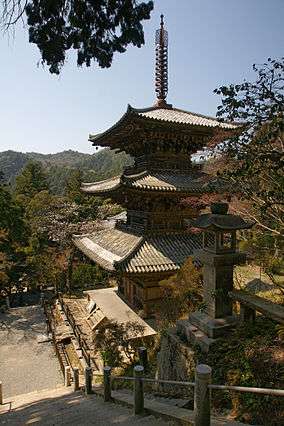 |
Indian Buddhism
Regarding Pure Land practice in Indian Buddhism, Hajime Nakamura writes that as described in the Pure Land sūtras from India, Mindfulness of the Buddha (Skt. buddhānusmṛti) is the essential practice.[32] These forms of mindfulness are essentially methods of meditating upon Amitābha Buddha.[32] Andrew Skilton looks to an intermingling of Mahāyāna teachings with Buddhist meditation schools in Kashmir for the rise of Mahāyāna practices related to buddhānusmṛti, mindfulness of the Buddha:[33]
Great innovations undoubtedly arose from the intermingling of early Buddhism and the Mahāyāna in Kashmir. Under the guidance of Sarvāstivādin teachers in the region, a number of influential meditation schools evolved which took as their inspiration the Bodhisattva Maitreya. [...] The Kashmiri meditation schools were undoubtably highly influential in the arising of the buddhānusmṛti practices, concerned with the 'recollection of the Buddha(s)', which were later to become characteristic of Mahāyāna Buddhism and the Tantra.
Chinese Buddhism
In Chinese Buddhism, Pure Land practice never became a sect of Buddhism separate from general Mahāyāna practice.[34] In particular, Pure Land and Zen practice are often seen as being mutually compatible, and no strong distinctions are made.[35] Chinese Buddhists have traditionally viewed the practice of meditation and the practice of reciting Amitābha Buddha's name, as complementary and even analogous methods for achieving enlightenment.[35] This is because they view recitation as a meditation method used to concentrate the mind and purify thoughts.[35] Chinese Buddhists widely consider this form of recitation as a very effective form of meditation practice.[35]
Historically, many Buddhist teachers in China have also taught both Chán and Pure Land together. For example, in the Ming Dynasty, Hanshan Deqing and many of his contemporaries advocated the dual practice of the Chán and Pure Land methods, advocating mindfulness of Amitābha Buddha to purify the mind for the attainment of self-realization.[36]
Tibetan Buddhism
Tibetan Pure Land Buddhism has a long and innovative history dating from the 8th-9th centuries CE, the times of the Tibetan Empire, with the translation and canonization of the Sanskrit Sukhāvatīvyūha sūtras in Tibetan. Tibetan compositions of pure-land prayers and artistic renditions of Sukhāvatī in Central Asia date to that time. Tibetan pure-land literature forms a distinct genre and encompasses a wide range of scriptures, "aspiration prayers to be born in Sukhāvatī" (Tib. bde-smon), commentaries on the prayers and the sūtras, and meditations and rituals belonging to the Vajrayāna tradition. The incorporation of phowa (mind transference techniques) in pure-land meditations is textually attested in the 14th century, in The Standing Blade of Grass (Tib. 'Pho-ba 'Jag-tshug ma), a terma text allegedly dating to the time of the Tibetan Empire. A good number of Buddhist treasure texts are dedicated to Buddha Amitābha and to rituals associated with his pure-land, while the wide acceptance of phowa in Tibetan death rituals may owe its popularity to pure-land Buddhism promoted by all schools of Tibetan Buddhism.[37]
There are many treasure texts associated with Tibetan Pure Land Buddhism [38] and terton Rigdzin Longsal Nyingpo (1625–1682/92 or 1685–1752) of Katok Monastery revealed a terma on pure land.[39] This terma entailed phowa during the bardo of dying, sending the mindstream to a pureland.
Gyatrul (b. 1924),[40] in a purport to the work of Chagmé (Wylie: Karma-chags-med, fl. 17th century), rendered into English by Wallace (Chagmé et al., 1998: p. 35), states:
It is important to apply our knowledge internally. The Buddha attained enlightenment in this way. The pure lands are internal; the mental afflictions are internal. The crucial factor is to recognize the mental afflictions. Only by recognizing their nature can we attain Buddhahood.[41]
Japanese Buddhism
In Japanese Buddhism, Pure Land teachings developed into independent institutional sects, as can be seen in the Jōdo-shū, Jōdo Shinshū, Yūzū-nembutsu-shū, and Ji-shū.[42]
Strong institutional boundaries exist between sects which serve to clearly separate the Japanese Pure Land schools from the Japanese Zen schools.[35] One notable exception to this is found in the Ōbaku Zen school, which was founded in Japan during the 17th century by the Chinese Buddhist monk Yinyuan Longqi (J. Ingen Ryuki). The Ōbaku Zen school retains many Chinese features such as mindfulness of Amitābha Buddha through recitation, and recitation of the Pure Land sūtras.[43]
Upon encountering Japanese Pure Land traditions which emphasize faith, many westerners saw outward parallels between these traditions and Protestant Christianity. This has led many western authors to speculate about possible connections between these traditions.[44] However, the cosmology, internal assumptions, and underlying doctrines and practices are now known to have many differences.[44]
See also
- Infinite Life Sutra (Longer Sukhāvatīvyūha Sūtra)
- Amitabha Sutra (Shorter Sukhāvatīvyūha Sūtra)
- Amitayurdhyana Sutra (Amitāyus Meditation Sūtra)
- Sukhavati
- Amitābha
- Faith in Buddhism
- Ippen
- Yuzu Nembutsu
- Vyuha
- Pariṇāmanā
Notes
- ↑ You Were Born For a Reason Archived October 29, 2013, at the Wayback Machine.
- ↑ Amidism, Britannica Online Encyclopedia
- ↑ Amidism The Columbia Encyclopedia
- ↑ Skilton, Andrew. A Concise History of Buddhism. 2004. p. 104
- ↑ "The Korean Buddhist Canon: A Descriptive Catalog (T. 361)".
- ↑ Mukherjee, Bratindra Nath. India in Early Central Asia. 1996. p. 15
- ↑ "Gandharan Sculptural Style: The Buddha Image".
- ↑ Inagaki, Hisao. The Three Pure Land Sutras. 2003. pp. xiii–xiv
- 1 2 Inagaki, Hisao. The Three Pure Land Sutras. 2003. p. xiv
- ↑ Harrison, Paul. McRae, John. The Pratyutpanna Samādhi Sūtra and the Śūraṅgama Samādhi Sūtra. 1998. pp. 2-3, 19
- ↑ Inagaki, Hisao. The Three Pure Land Sutras. 2003. p. xiii
- ↑ Skilton, Andrew. A Concise History of Buddhism. 1997. p. 104
- 1 2 3 Inagaki, Hisao. The Three Pure Land Sutras. 2003. p. xvi
- ↑ Larger Sutra of Immeasurable Life: Part 1
- ↑ Nan, Huai-Chin. Basic Buddhism: Exploring Buddhism and Zen. 1997. p. 83
- ↑ Nan, Huai-Chin. Basic Buddhism: Exploring Buddhism and Zen. 1997. p. 81
- ↑ Nan, Huai-Chin. Basic Buddhism: Exploring Buddhism and Zen. 1997. p. 82
- ↑ Dumoulin, Heinrich and James W. Heisig, Paul F. Knitter (2005). Zen Buddhism : a History: India and China. World Wisdom Inc. p. 67. ISBN 0-941532-89-5.
- ↑ Takeuchi, Yoshinori & Jan van Bragt (1993). Buddhist Spirituality: Indian, Southeast Asian, Tibetan, and early Chinese. Crossroad Publishing Company, original from University of Virginia. p. 283. ISBN 0-8245-1277-4.
- ↑ Nan, Huai-Chin. Basic Buddhism: Exploring Buddhism and Zen. 1997. p. 91
- ↑ Foard, James Harlan. The Pure Land Tradition: History and Development, Fremont, CA: Jain Publishing 2006. ISBN 9780895810922. p. 110
- ↑ Birmingham Museum of Art (2010). Birmingham Museum of Art: Guide to the Collection. London, UK: GILES. pp. 30–31. ISBN 978-1-904832-77-5. Retrieved 2011-07-08.
- ↑ Luk, Charles. The Secrets of Chinese Meditation. 1964. pp. 83–84
- 1 2 Luk, Charles. The Secrets of Chinese Meditation. 1964. p. 83
- 1 2 3 Luk, Charles. The Secrets of Chinese Meditation. 1964. p. 84
- 1 2 Yuan, Margaret. Grass Mountain: A Seven Day Intensive in Ch'an Training with Master Nan Huai-Chin. 1986. p. 55
- ↑ Kenneth K Tanaka (1990). The Dawn of Chinese Buddhist Doctrine: Ching-Ying Hui-Yuan's Commentary on the Visualization Sutra. p. 51. Retrieved 10 September 2012.
- ↑ Luk, Charles. The Secrets of Chinese Meditation. 1964. p. 85
- 1 2 Inagaki, Hisao. The Three Pure Land Sutras. 2003. p. xix
- ↑ 淨空法師佛學問答(死生篇)
- ↑ Taisho Tripitaka no 1865
- 1 2 Nakamura, Hajime. Indian Buddhism: A Survey with Bibliographical Notes. 1999. p. 205
- ↑ Skilton, Andrew. A Concise History of Buddhism. 2004. p. 162
- ↑ Sharf, Robert (2002). On Pure Land Buddhism and Pure Land/Chan Syncretism in Medieval China, T`oung Pao Vol. 88 (4-5), 283-285
- 1 2 3 4 5 Prebish, Charles. Tanaka, Kenneth. The Faces of Buddhism in America. 1998. p. 20
- ↑ Keown, Damien. A Dictionary of Buddhism. 2003. p. 104
- ↑ Luminous Bliss: A Religious History of Pure Land Literature in Tibet, 2013, by Georgios T. Halkias, University of Hawaii Press.
- ↑ Luminous Bliss: A Religious History of Pure Land Literature in Tibet, 2013, by Georgios T. Halkias, University of Hawaii Press, chapter 5.
- ↑ Khadro, Chagdud (1998, 2003). P'howa Commentary: Instructions for the Practice of Consciousness Transference as Revealed by Rigzin Longsal Nyingpo. Junction City, CA, USA: Pilgrims Publishing
- ↑ Source: biography (accessed: August 26, 2013)
- ↑ Chagmé, Karma (author, compiler); Gyatrul Rinpoche (commentary) & Wallace, B. Alan (translator) (1998). A Spacious Path to Freedom: Practical Instructions on the Union of Mahamudra and Atiyoga. Ithaca, New York, USA: Snow Lion Publications. ISBN 978-1-55939-071-2; ISBN 1-55939-071-9, p.35
- ↑ Guide on Buddhism for America
- ↑ Baroni, Helen Josephine. Iron Eyes: The Life and Teachings of the Ōbaku Zen master Tetsugen Dōko. 2006. pp. 5–6
- 1 2 Bloom, Alfred. The Shin Buddhist Classical Tradition. 2013. p. xii
Further reading
- Amstutz, Galen (1998). The Politics of Pure Land Buddhism in India, Numen 45 (1), 69-96 – via JSTOR (subscription required)
- Inagaki, Hisao, trans. (2003), The Three Pure Land Sutras (PDF), Berkeley: Numata Center for Buddhist Translation and Research, ISBN 1-886439-18-4, archived from the original (PDF) on May 12, 2014
- Müller, F. Max (trans) Buddhist Mahâyâna texts Vol.2: The larger Sukhâvatî-vyûha, the smaller Sukhâvatî-vyûha, the Vagrakkedikâ, the larger Pragñâ-pâramitâ-hridaya-sûtra, the smaller Pragñâ-pâramitâ-hridaya-sûtra. The Amitâyur dhyâna-sûtra, translated by J. Takakusu. Oxford, Clarendon Press 1894. Pure Land Sutras
- Shi Wuling: In one Lifetime: Pure Land Buddhism, Amitabha Publications, Chicago 2006. ISBN 9781599753577
- Halkias, Georgios: Luminous Bliss: A Religious History of Pure Land Literature in Tibet, with an annotated English translation and critical edition of the Orgyan-gling Gold manuscript of the short Sukhāvatīvyūha-sūtra. Hawaii: University of Hawai‘i Press 2013.
- Shinko Mochizuki, Leo M. Pruden,Trans. (1999). Pure Land Buddhism in China: A Doctrinal History, Chapter 1: A General Survey. In: Pacific World Journal, Third Series, Number 1, 91-103. Archived from the original
- Shinko Mochizuki, Leo M. Pruden,Trans. (2001). Pure Land Buddhism in China: A Doctrinal History, Chapter 2: The Earliest Period; Chapter 3: Hui-yuan of Mt.Lu; and Chapter 4: The Translation of Texts-Spurious Scriptures. In: Pacific World Journal, Third Series, Number 3, 241-275. Archived from the original
- Shinko Mochizuki, Leo M. Pruden,Trans. (2002). Pure Land Buddhism in China: A Doctrinal History, Chapter Five: The Early Pure Land Faith: Southern China, and Chapter Six: The Early Pure Land Faith: Northern China. In: Pacific World Journal, Third Series, Number 4, 259-279. Archived from the original
- Shinko Mochizuki, Leo M. Pruden,Trans. (2000). Pure Land Buddhism in China: A Doctrinal History, Chapter 7: T'an-luan. In: Pacific World Journal, Third Series, Number 2, 149-165. Archived from the original
- Kenneth Tanaka (1989). Bibliography of English-language Works on Pure land Buddhism: Primarily 1983-1989, Pacific World Journal, New Series, Number 5, 85-99. PDF
External links
| Wikisource has original text related to this article: |
- Pureland Buddhism official website
- Jōdo Shū Buddhism official website
- Homepage for Jodo Shinshu Hongwanji-ha Hongwanji International Center—English
- Amitabha Pure Land Web (in English)
- Homepage for Amitabha Foundation
- Dennis Hirota: Japanese Pure Land Philosophy. In: Edward N. Zalta (Hrsg.): Stanford Encyclopedia of Philosophy

